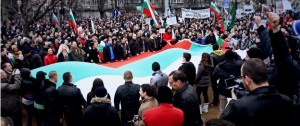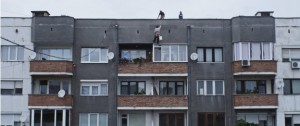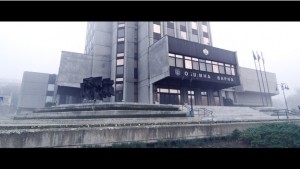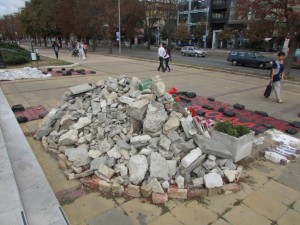LeftEast recently sat down with Martin Marinos and Andre Andreev to discuss their film ‘Flame: A Short Film About Plamen Goranov,’ which recently won the Thessaloniki Film Festival’s Audience Award for Best Short Film. The documentary explores the life of Plamen Goranov whose self-immolation during the Bulgarian protests in 2013 spurred the resignation of Varna’s mayor and was also cited by the Prime Minister Boyko Borisov as one of the reasons for his resignation. Martin and Andre have generously made the entire film available to LeftEast readers.
- Tell us a little bit about how the idea for this film came about, and what drove you in particular to the story of Plamen Goranov?
Andre: The idea for the film came largely from Martin. In 2013 he was following the news of self-immolations and electricity protests in Bulgaria, and was sending me articles about the situation. What surprised both of us was the lack of media coverage of these events outside of Bulgaria. There were a few articles written in European and American outlets, but most people outside of the Balkans were completely unaware of these events. Through our film, we wanted to shed a little more light on the situation. At the time there were a total of seven self-immolations. The decision to focus on Plamen was something we debated. At the end, we settled on him because his case was widely publicized and therefore we could find the most information about him. I was also very intrigued by his creativity, in particular his photography, and that’s something that swayed me to focus on him.
Winter protests in Bulgaria from 2013 (video still from ‘Flame’).
- Why did you think it was important to name the film Flame?
Martin: Besides the obvious connection to the act of self-immolation, there is another factor that led us to this title. Plamen’s name derives from the word ‘flame.’ For an audience that does not speak Bulgarian, we should note that the connection between his name and final act did not end there. His surname, ‘Goranov,’ derives from the Bulgarian verb ‘to burn.’ At first we thought of naming the film simply ‘Plamen.’ But our experience of screening the film to a non-Bulgarian, English-speaking audience is that people mispronounce and struggle with this Bulgarian name. Thus, there was this practical aspect to our choice of title for the film. We want a global audience to be able to remember the film and make the connection between his name and his act of protest.
- In some ways Plamen bridges the identities of manual worker (construction) and creative worker (photography), often portrayed as two irreconcilable identities in postsocialist Bulgaria. What are the tensions between these identities/worlds and what are some points of commonality worth considering?
Martin: Plamen was both an artist and a manual worker. To us this was an important part of his story. In many ways, his life reminded me of Jacques Ranciere’s book Proletarian Nights: The Workers’ Dream in Nineteenth Century France. In it, Ranciere describes how instead of using the night to recuperate their strength, proletarians wrote poems, music and engaged in artistic activities. According to Ranciere, they resisted precisely the attempts to bracket their lives into a single sphere. Plamen’s capacity to engage with creative work, while also maintaining a manual job that earned him a living, resonates with the premise of Ranciere’s dissertation. What is more, we should note here that in this short film we only scratch the surface of the creative artistic energy of Plamen Goranov. We focus on some of his work as a photographer, but Plamen’s interests were not limited to photography.
We know, for instance, that he also produced plays. In one of his plays, staged in the marine park in Varna three of Plamen’s friends are dressed as the worms “T” “I” and “M,” the initials of TIM, which stand for the company viewed by many as an oligarchic structure exploiting the city and its people. Another friend of Plamen’s acts as the “golden apple,” a metaphor for the city of Varna, which the worms want to devour. Plamen, himself is dressed as a television set which spreads the media lies of “T,” “I,” and “M.” The audience of Plamen’s play are predominantly children and mothers with strollers. At the end of it the children are summoned to the stage to fight the worms and save the “golden apple.” A jolly scene of ecstatic children ensues.
There are other examples of Plamen’s artistic work. Shortly after the Pussy Riot controversy, he used his skills as a climber and managed to place pink bags over the heads of the soldiers that are part of the monument to “Bulgarian-Soviet Friendship” in Varna. This was an act that drew some media attention because it stood out with its creativity, going beyond the standard pouring of paint, the spraying of Nazi graffiti, or the outright destruction that often befalls these monuments. Another example of Plamen’s talent is illustrated by a music video of the popular Bulgarian pop-rock group Django Ze. The idea of the clip, which takes place in an impoverished Roma neighborhood on the Black Sea coast, was Plamen’s. The song, called “Dvama” (“Two” in English) begins with a shot of a black and a white sheep. The song is anti-racist and anti-xenophobic – a rare occurrence in contemporary Bulgarian music. Plamen can be seen dancing and clapping throughout the clip.
The list goes on. In fact we continue to discover more about his creative work. For example, after the film screening in Varna, a friend of his approached us and told us a fascinating story. Years ago, she had visited Romania with Plamen, where in a remote town he managed to befriend a chimney sweeper. For a couple of days Plamen worked with him, while also photographing the rare experience.
A sample of Plamen Goranov’s photography (video still from ‘Flame’).
- How does Plamen’s life story fit into the broader story of working-class Bulgarians and the wave of protests that swept the country in the past few years?
Martin: In the Bulgarian media, the framing of Plamen’s case changed frequently. Initially, the media said his act was unrelated to the protests that were taking place.. But afterwards, Plamen’s self-immolation began receiving the most attention. He was singled out as the only self-immolator who was driven by his ‘own moral consciousness,’ rather than say desperation or economic hardship. This media narrative created an impression of Plamen as a relatively well-off, young professional, who maybe worked in an office (perhaps an air-conditioned one!) and was estranged from the daily struggles of ordinary people. But during our interviews, a different image of Plamen emerged. In the film, one of his co-workers describes the job he did as an elevation worker as ‘brutally hard,’ noting that after a shift their hands would be covered in blisters. Furthermore, a number of his friends shared with us that Plamen faced chronic economic hardship and lived in rather humble living arrangements. In other words, the portrayal of him in the media as economically stable was misleading. Recently Business Insider quoted an EU-wide survey, which reported that 48 percent of Bulgaria’s 7.2-million people live in material deprivation, defined as “being unable to afford things like adequate heating or meat every second day.” Plamen was quite familiar with these hardships and his decision to participate in the predominantly working-class, winter protests that had erupted against high electricity prices was not an aberration.
Plamen’s co-workers labouring on a building’s facade in Varna (video still from ‘Flame’).
- The story of Plamen can be told in a very personal way, or as part of a broader structural analysis of Bulgaria in the post-socialist era. In the movie you try to do both, but still more emphasis is put on the personal story – why is that?
Andre: First and foremost we wanted to understand Plamen as a person. So much of the attention on him was focused on his death and we wanted to learn about his life. We considered expanding the film to include a critical context and an analysis of post-socialism in Bulgaria. But we would have had to make a much longer film. In addition, we concentrated on Plamen because we knew that his story would resonate on an emotional level regardless if the audience are familiar with Bulgaria or not.
- Plamen’s self-immolation falls within a broader pattern of self-immolations at the time around the world. How was this act (and others like it) received in Bulgaria? Ultimately, what is the legacy of Plamen’s act?
Martin: Politically motivated self-immolations have a long history. There are examples from ancient Greece. In India self-immolations occur every week. But in Bulgaria, this is unprecedented and came as a shock to many. These cases tell us unequivocally that something has gone terribly wrong. While for many, the self-immolations in Bulgaria highlighted existing levels of desperation and poverty, others sought to minimize their political significance. Often, the immolators were depicted as “drug addicts,” “mad,” “crazy” or “suicidal.” One of the more troubling explanations of this sort was produced by the prosecutor’s office, which investigated Plamen’s case. In a remarkable ten-page document the local authorities engaged in a pseudo-Freudian analysis of Plamen. They argued that Plamen, who did not have a good relationship with his father, had transferred his animosity towards him to Kiril Yordanov—the mayor of the city of Varna. Thus Plamen’s participation in the protests was attributed to his personal family dynamics and his anger was reduced to a perception of the mayor as a father figure.
- The film dwells a lot on the built environment of Varna, with long shots that dwell on its (post)socialist architectures and landscapes. Why was it important to focus on the city-scape throughout the film?
Andre: It was important to dwell on the long, wide shots of Varna for two reasons. The first one is purely illustrative: we wanted to show what Bulgaria looks like. The second one is emotive: we wanted to show the mood in Varna and the disenchantment that Plamen must have felt. Most of the shots in the film are very wide. This gives an overall feeling of loneliness which is underlined by the thick fog that engulfs the city in the winter mornings. These shots show the enormous difference in scale between the post-socialist architecture and the human size. We wanted the audience to feel what Plamen must have felt on the morning of his immolation: he was a man with a strong sense of justice, standing at the bottom of a faceless slab of concrete, trying to make his voice heard.
Varna City Hall (video still from ‘Flame’).
- In the last minutes of the movie you show a big pile of stones, which people have put together as a sign of commemoration. To the eyes of a foreigner this figure may look peculiar – does it have any relevance in Bulgarian history or recent protest culture?
Martin: We don’t know how the idea for the makeshift monument emerged. Most likely, it was a spontaneous expression of anger and sorrow. Two years later, this people’s monument continues to mark the spot where Plamen’s body was burnt. But besides its function as a shrine where people can light candles in Plamen’s memory, it also serves as a place where people express their political feelings and grievances. When I first visited the site, a leftist group had placed a poster of Hristo Botev, one of Bulgaria’s revolutionaries against Ottoman rule. Botev, who was inspired by the Paris Commune, is claimed by both anarchists and communists. One of his quotes, written in red letters on a black background and placed at the site of Plamen’s monument, states: “The poor Turks are not our enemies! Our real enemies are the chorbadzhii” (i.e the Christian village elite in the Balkan parts of the Ottoman Empire, which was made up of wealthy traders, landowners, and lenders).” However, not far from this quote, one could find outright nationalist and xenophobic messages as well. There was another poster directed against one of Bulgaria’s largest media moguls. Even a placard critical of the inadequacies in public transportation has found room there. It is a very eclectic and constantly changing site, serving as a daily reminder to the city government of its multiple failures. However, they have been reluctant to remove the stones. On several occasions, rumors that someone was trying to remove rocks from the monument mobilized people to rush to the scene and defend it. After the screening of our film in Varna, a protester told us that the municipality wanted to replace the monument with a giant iron heart with an opening at the top. He described it as a big piggy-bank in which people could place stones in memory of Plamen. The protester who spoke to us was strongly opposed to the idea, because he saw it as an attempted “representation of the people’s love” and “we” he said “have no love for them [the authorities]. We have a lot of anger.” It was a statement I won’t forget.
Monument to Plamen Goranov at the location of his self-immolation in front of Varna City Hall (video still from ‘Flame’).
- The movie ends with a rather hopeful narrative of what Plamen’s death has achieved. While this might have been the case in the immediate aftermath of the protests, now we are in 2015, two years after his death. What are your reflections on the current situation in Bulgaria and what the mobilizations in 2013 achieved?
Martin: Many argue that the self-immolations had no effect. But both the mayor of Varna and the Prime Minister Boyko Borisov mentioned Plamen’s death as a reason for their resignations. The winter demonstrations as a whole, were not inconsequential. Even the electricity companies changed their rhetoric and more recently made some small concessions. However, the feeling that little had been achieved is not baseless. Today Boyko Borisov is once again the Prime Minister. His right-wing party committed to austerity has returned to power. The current mayor of Varna, who avoided an interview with us, does not seem to be all that different from his predecessor. In this sense, little has changed except for the fact that a number of people, such as Plamen Goranov, are no longer with us because they chose to die in an incredibly painful way. But, we believe that it is still too early to understand the meaning of the self-immolations and the winter mobilizations of 2013. We have yet to see what will be their place in the string of protests and mobilizations that are surely to occur in the near future, precisely because so little has changed.
- How has the film been received abroad? How was it received in Bulgaria?
Andre: In Bulgaria the film was described as polarizing and polemical. The media was very interested in it and we were invited to be interviewed on the major TV and radio stations in the country. The release of the film coincided with the two year anniversary of Plamen’s death. We premiered it at the Sofia Film Festival where both screenings were sold out. Those were very positive reactions, but there were some negative ones as well. Many people in Bulgaria think that Plamen’s self-immolation was an act of suicide and not an act of protest. From that point of view their critique of the film stems from the belief that we are somehow celebrating an act of suicide by making a film about Plamen. I think that this argument is far from the truth. Also, some people had more cynical views and thought that we are somehow trying to become famous and rich by promoting this tragedy. There were some constructive criticisms as well. Most notably some thought that the film could have been longer and could have covered more aspects of Plamen’s life. Abroad the reception has been fantastic. We received the audience award for short films at the Thessaloniki Film Festival in Greece and were invited to the San Francisco and Seattle film festivals. After the screenings, the first comment people usually share is their surprise that they haven’t heard anything about the self-immolations in Bulgaria before seeing the film.
- What other stories are you now working on or planning to tell about Bulgaria, or on any other subject?
Andre: We have a few ideas in the works, but for now we are focused on promoting our film about Plamen and continuing the conversation around the current state of affairs in Bulgaria. Outside of Bulgaria, we just finished a short film on the minister of culture for the Black Panther party, Emory Douglas.
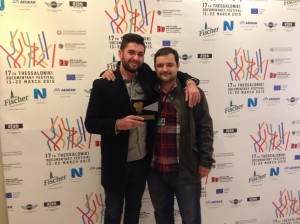 Andreev and Marinos after winning the Thessaloniki Film Festival’s Audience Award for Best Short Film.
Andreev and Marinos after winning the Thessaloniki Film Festival’s Audience Award for Best Short Film.
Andre Andreev is a New York based filmmaker. He is a partner in the production company dress code with Dan Covert where he splits his time between commercial and documentary projects.
Martin Marinos is a PhD Student in Media and Communication at the University of Pittsburgh and a member of social center Xaspel and New Left Perspectives in Bulgaria. His dissertation is on the (neo)liberal transformation of the Bulgarian media sphere after 1989 and its influence on the popularity of far-right discourse.


